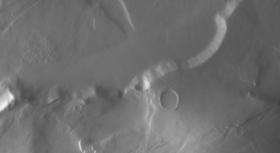Dawn Finishes Mars Phase

(PhysOrg.com) -- With Mars disappearing in its metaphorical rearview mirror, NASA's Dawn spacecraft's next stop is the asteroid belt and the giant asteroid Vesta. Dawn got as close as 549 kilometers (341 miles) to the Red Planet during its Tuesday, Feb. 17, flyby.
Dawn's navigators placed the spacecraft on a close approach trajectory with Mars so the planet's gravitational influence would provide a kick to the spacecraft's velocity. If Dawn had to perform these orbital adjustments on its own, with no Mars gravitational deflection, the spacecraft would have had to fire up its engines and change velocity by more than 9,330 kilometers per hour (5,800 miles per hour).
The achieved goal of the flyby was to obtain this orbital pick-me-up, making possible its voyage to asteroid Vesta and, later, the dwarf planet Ceres. But Dawn's science teams used this massive target of opportunity to also perform calibrations of some of the scientific instruments. Calibration images were taken by Dawn's framing camera, and the Gamma Ray and Neutron Detector also observed Mars for calibration. These data will be compared to similar observations taken by spacecraft orbiting Mars.
Further observations were planned during the flyby, but fault detection software canceled the data collection and put the spacecraft into safe mode, a limited-activity precautionary status. The cause was determined to be an inappropriate software response to an expected temporary loss of valid data from the spacecraft's star tracker in the vicinity of Mars, and engineers were able to restore the spacecraft to normal operations within 48 hours.
While the spacecraft will never be back in the vicinity of Mars again, the Dawn team is using the event to fine-tune its software.
The spacecraft has already traveled about 1.8 million kilometers (1.1 million miles) beyond Mars. It has 30 months and 1.8 billion kilometers (1.1 billion miles) to go before its rendezvous with Vesta in 2011.
Dawn's 4.8-billion-kilometer (3-billion-mile) odyssey includes orbiting Vesta and the dwarf planet Ceres in 2015. These two giants of the asteroid belt have been witness to much of our solar system's history. By using Dawn's instruments to study both objects for several months, scientists can more accurately compare and contrast the two. Dawn's science instrument suite will measure geology, elemental and mineral composition, shape, surface topography, geomorphology and tectonic history, and will also seek water-bearing minerals. In addition, the Dawn spacecraft's orbital characteristics around Vesta and Ceres will be used to measure the celestial bodies' masses and gravity fields.
Provided by NASA





















